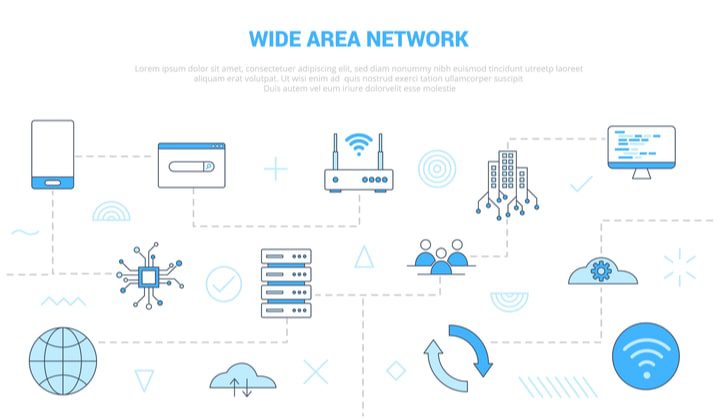
SD-WAN is quickly being adopted as the wide area network configuration of choice across multiple IT, voice, and data networking organizations and enterprises. It provides efficient, flexible and versatile software connections. This technology offers faster, smoother networks – a much-needed asset for IT personnel and network managers all around the globe. According to the State of the WAN report published in 2016, conventional WAN has tons of latency issues and packet data loss at higher levels. In this post, we’ll highlight the meaning of SD-WAN and its essential performance benefits.
What Is SD-WAN?
A software-defined wide area network (SD-WAN) is an online service that connects a number of wide area networks (WANs) spread out across regions and separated by hundreds or even thousands of miles. It can extend WAN enterprises across large geographical locations. WANs link together several local area networks (LANs) and use a number of internet link services, including MPLS, LTE, virtual private networks (VPNs) and wireless broadband to provide remote office access to corporate organizations. This allows users the services and resources to perform their tasks regardless of location.
Traditional WANs use dedicated multiprotocol label switching (MLPS) connections and physical routers as network range extenders, giving a large number of users online access without having to move close to the central host servers. Each router has a data plane to hold information and a control plane to direct data to where it needs to go. The direction of data flow is usually governed by the network engineer or admin, who drafts the network’s rules and policies for each router. This process takes a lot of time and is exposed to a lot of errors. It can also cause network congestion and data packet loss.
SD-WAN configuration isolates the data control and management processes from the routers and other network hardware, making them available as software that can be managed quickly, easily and efficiently with minimal errors. It provides organizations with a back and front end view of the network, and an ability to rank network traffic over other connections. Having the control plane as a software allows the SD-WAN to quantify traffic dynamics and choose the best route for each data packet, all in real time. SD-WAN combines conventional WAN technologies (such as service-only MLPS) with more budget-friendly broadband connections.
How SD-WAN Improves Application Performance
While conventional WAN configurations have worked just as well, here are all the reasons why SD-WAN architecture is rapidly gaining popularity in the IT world.
Speed and Availability
SD-WAN provides higher visibility and flexibility to support voice data packets. It gives network users a seamless, uninterrupted internet experience by providing the ability to rapidly shift traffic to and from private and public internet connections.
Efficient Load Balancing
The centralized and software-based nature of data control in SD-WANs, it sorts out all the different data streams and places them in efficient pathways to avoid clogging up the network. It places performance-intensive applications to less busy channels to provide a reliable flow of data and prevent data loss.
Affordability and Flexibility
SD-WAN makes moving non-essential WAN data traffic from private MLPS links to more affordable broadband internet connections a lot easier. This is made possible by its centralized data management model that allows the network admin to control the amount of traffic on broadband links anytime without having to reconfigure routers every time. The data control engineer can perform routine maintenance and service checks on the network without having to travel to router locations. This can all be done from the office by using the centralized, policy-based data management model that SD-WAN offers.

How to Improve Your Network Application Performance With SD-WAN
1. Identify and Prioritize Network Traffic
Your network engineer can use a policy and rule-based system to create a set of directions that govern each application in the network. This allows the SD-WAN system to rank data streams based on performance in the system and steer data packets of critical applications down paths with maximum bandwidth and minimal holdup. The rules can also apply to the opposite set of data by ranking lower priority data packets and setting them down paths with higher traffic. This will make browsing easier for all your network users.
2. Direct Traffic Toward the Path of Least Congestion
SD-WAN tracks the bandwidth of each network link using metrics such as latency, packet jitter and dropped data packets, which worsen as congestion increases or when there is a problem with WAN connections. The network can be set up such that it recognizes unhealthy network links and steer traffic away from congested links.
3. Use a Hybrid Model
You can combine WAN optimization and SD-WAN configuration to make your overall network application performance more efficient. While SD-WAN can steer data traffic away from congested links, this feature is of little use if all WAN links are unhealthy. WAN optimization improves the performance of congested links and high-latency connections by using a combination of diverse solutions to reduce the number of data packets sent across each unhealthy connection. This boosts data transfer speeds and reduces bandwidth demands.
WAN optimization can also reduce and even eliminate the effects of latency by restructuring unproductive protocols, when the server and client are in different geographic locations and separated by long distances.
Leverage SD-WAN With Us
SD-WAN makes it possible for IT teams to redesign, launch and manage complex networks with greater speeds and efficiency than conventional WAN configurations. It allows service providers to mitigate latency, data packet loss, and downtime while increasing network performance and return on investment.
If you need more information, please contact us today.
